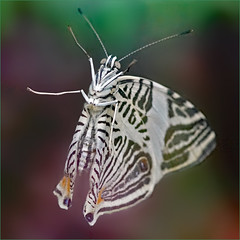.
In Explore, October 28, 2024
No, this butterfly is not the famous glasswing (Greta oto) from Central America, but the larger lesser known giant glasswing or confusa tigerwing (Methona confusa) from South America.
The glasswing (Greta oto) has a wingspan of 4.5 to 6.0 cm; the giant glasswing (Methona confusa) has a wingspan of 7.0 to 9.5 cm.
Both species have characteristic transparent wings.
The opaque borders of the wings of the giant glasswing are black. The margins of the hindwings show a series of small white spots. The body has a double parallel series of conspicuous white spots. Antennae are black, with yellowish tip.
The giant glasswing can be found in Brazil, Ecuador, Panama, Peru and Colombia. Adult giant glaswings inhabit the tropical rainforest at altitudes below about 700m, and feed on the nectar of a variety of tropical flowers.
Nee, dit is niet de bekende glasvleugelvlinder (Greta Oto) uit Midden-Amerika, maar een minder bekende nauw verwante veel grotere soort, de grote glasvleugelvlinder of giant glasswing (Methona confusa) uit Zuid-Amerika.
De glasvleugelvlinder (Greta Oto) heeft een vleugelspanwijdte van 4,5 à 6,0 cm; de grote glasvleugelvlinder (Methona confusa) heeft een vleugelspanwijdte van 7,0 à 9,5 cm.
Beide soorten hebben kenmerkende doorzichtige vleugels.
De niet doorzichtige aderen van de grote glasvleugelvlinder zijn zwart. Op de zwarte randen van de achtervleugels zitten kleine witte vlekken. Op het lichaam zit een dubbele rij opvallende kleine witte punten. De antennes zijn zwart met een geelwit uiteinde.
De grote glasvleugelvlinder is te vinden in Brazilië, Ecuador, Panama, Peru en Colombia, waar ze in de tropische regenwouden tot een hoogte van 700 meter voorkomen.
Ze voeden zich met nectar van verschillende bloemen.
Deze foto is gemaakt in het vlinderhuis van de Botanische Tuinen van de Utrechtse Universiteit.
________________________
All rights reserved. Copyright © Martien Uiterweerd (Foto Martien). All my images are protected under international authors copyright laws and may not be downloaded, reproduced, copied, transmitted or manipulated without my written explicit permission.
________________________
.
.



















